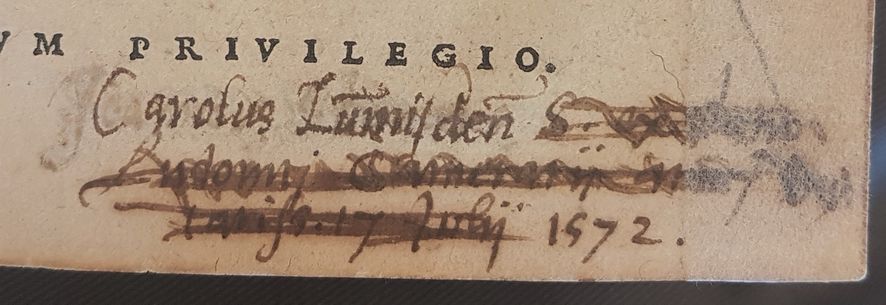Difference between revisions of "Charles Lumsden ca.1561-1630"
(Created page with "__NOTITLE__ ===name::Charles name:LUMSDEN or name::LUMISDEN ca.date of birth::1561-date of death::1630=== ====Biographical Note==== He was the son of fa...") |
|||
| Line 1: | Line 1: | ||
__NOTITLE__ | __NOTITLE__ | ||
| − | ===[[name::Charles]] [[name:LUMSDEN]] or [[name::LUMISDEN]] ca.[[date of birth::1561]]-[[date of death::1630]]=== | + | ===[[name::Charles]] [[name::LUMSDEN]] or [[name::LUMISDEN]] ca.[[date of birth::1561]]-[[date of death::1630]]=== |
====Biographical Note==== | ====Biographical Note==== | ||
Revision as of 09:56, 21 April 2023
Charles LUMSDEN or LUMISDEN ca.1561-1630
Biographical Note
He was the son of Andrew Lumsden, a tailor and burgess of Edinburgh. In 1588, he was appointed minister of Duddingston, and remained in the post for the rest of his life. He married Beatrice Pont, daughter of Robert Pont, minister of St. Cuthbert’s, and had 3 children. He then married Katherine Bruce, and had a son; he then married Beatrix Muirhead and had seven more children, including Charles, his successor.
Between 1586 and 1587 he was regent of the University of Edinburgh. In 1600, he published an English translation of Robert Rollock's Exposition upon Some Select Psalms of David. In 1614, he was admitted burgess of Edinburgh. In 1617, he signed the protest to King and Parliament in support of the liberties of the Kirk.
Books
Charles Lumsden is a familiar name to anyone acquainted with book ownership in sixteenth- and early seventeenth-century Scotland, as his inscription is on the title page of many of the books belonging to Scots of that era, now held in institutional collections. However there has been no assessment of the size and contents of Lumsden’s library, which appears to have comprised of at least a few hundred volumes, and was dispersed after his death. His books bear the previous provenance of pre-reformation Scots such as William Gordon fl.1540-1577; John Sinclair ca.1510-1566 (EUL *T.18.2/1); and John Greenlaw of Haddington (d.1566) (NLS H.35.a.10) (Further examples can be found in Durkan & Ross). Several volumes were acquired after Lumsden’s death by William Struthers 1578-1633 and the Rev. James Nairn.
Lumsden owned a range of books on theology, law and science, and what survives is dominated by continental imprints, usually in Latin. Books previously owned by him include:
A first edition of Conrad Gesner’s Historia animalium (Zurich, 1551-1558) (Sp Coll Bh5-b.1-3), acquired by Lumsden in May 1598.
A 1598 edition of Dodoens’ A New Herbal, or historie of plants (London, 1586) (EUL JA 1065)
A first edition of Hector Boece Scotorum historiae (Paris, 1527) (NLS RB.m.227) previously owned by Alexander Stevenson (fl.1548), rector of Forvie, Aberdeenshire.
The work Bibliotheca selecta de ratione studiorum, ad disciplinas, et ad salutem omnium gentium procurandam, comprising of a selection of texts for the education of Catholics and the saving of their souls by the Jesuit scholar of the counter reformation Antonio Possevino, (Sp Coll Bn8-c.9 ).
Lumsden also had antiquarian interests, and owned two thirteenth-century manuscripts of the Vulgate bible (Preserved at Edinburgh University; MS1 and MS 6)
The inscriptions on several of his volumes reveal Lumsden’s personal connections. He gifted a Froben edition of St Basil to the advocate Thomas Henryson (d.1638), “et nunc Thomae Henrysonis ex dono Caroli” (TypSwB.B32FB). In 1625, Lumsden also gifted one of three incunabula he owned to John Maxwell (1586-1647), Bishop of Ross, "Carolus Lumisden Joanni Mackuswellio fratri & sumystae in Christo chariss. D.D. 2. VIIbris 1625.” The book was Pierre d’ Ailly’s commentary on Peter Lombard’s Sentences, acquired by Lumsden in 1607 (Sp Coll Bm1-e.10). His Pontificale Romanum (Venice, 1572) (EUL RB.F.379) was gifted to him by Sir David Lindsay (1551?-1610), who also gifted Lumsden a 1561 Paris edition of the Decretales of Pope Gregory IX (EUL RB.F.391) (These are numbers 1345 and 761 in the Lindsay Catalogue).
Characteristic Markings
Lumsden inscribed his books with his name, and often the date of acquisition. Examples of this are 'Caroli Lumisden. 24. Xbris. 1605' in Bamburgh Library G.S.18/1
'et nunc Carolae Lummisden. 24 Xbris 1605' in St Andrews TypSwB.B32FB
'Carolus Lumisden' in [Sp Coll Bh5-b.1-3 https://eleanor.lib.gla.ac.uk/record=b1776326].
Alongside his name, he often wrote 'Si deus pro nobis quis contra nos? Rom. 8. 31' (Example: GG.7/1.10).
He is not to be confused with his son, Charles Lumsden (1614-1686), who also acquired a large library and inscribed his books with his name. Their signatures are similar, and the most reliable way to distinguish them is by the date of acquisition, which both had a habit of entering into their books. At least two surviving volumes were owned and annotated by both of them, one of which is Seth Calvisius (1556-1615)’s Opus chronologicum : ex autoritate potissimùm sacrae scripturae et historicorum fide dignissimorum (EUL Dh.8.25)
Sources
- Bird, D. A Catalogue of Sixteenth-Century Medical Books in Edinburgh Libraries. Edinburgh, 1982.
- Durkan, J. & Ross, A. Early Scottish Libraries. Glasgow, John S. Burns, 1961.
- Scott, Hew et al. Fasti Ecclesiae Scoticanae: The Succession of Ministers in the Church of Scotland from the Reformation, 9 vols, new edn. Edinburgh, Oliver & Boyd, 1915–61.
- Simpson, Murray C. T. Scholarly Book Collecting in Restoration Scotland : the Library of the Revd James Nairn (1629-1678). Leiden: Brill, 2020.
- Jackson Williams, Kelsey, Jane Stevenson, and William Zachs. A History and Catalogue of the Lindsay Library, 1570–1792. Leiden, Leiden: Brill, 2022.

